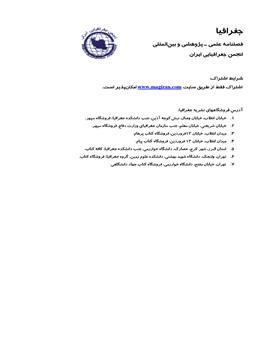Analysis of factors affecting the realization of an integrated urban management using factor analysis (Case Study Metropolis Tehran)
Subject Areas :
Farzaneh Salami
1
,
majid hazrati
2
,
majid شنذشقه
3
![]()
1 -
2 -
3 -
Keywords: integrated management of urban, metropolitan, urban management, analysis, Tehran metropolis,
Abstract :
The process of globalization, the rise has accelerated the world's metropolitan areas and has added new problems to existing problems. The extent and complexity of life and activity centers and areas close to the pulse of the metropolis at one point says, metropolitan management at the level of individual municipalities beyond the institutions separate and necessary. As problems and threats in the metropolitan area, the main challenge metropolises of the many opportunities that exist within them. In this regard, the present study aims to explore factors affecting the implementation of integrated management in metropolitan city of Tehran. This article depth study and applied developmental in nature and is based on descriptive and analytical approach. The study combines survey and gather information and documents and data via questionnaire and population groups and city managers, specialists and experts in the city of Tehran. Based on factor analysis, 5 of the 27 indicators studied were all having recognized special value is high and a total of 68.501 of the variance. The results also indicate that legal infrastructure components with a correlation coefficient 0.805, 0.801 urban poor information infrastructure for integrated management, Overlapping corporate functions in different organs of the municipal administration 0.782, Lack of accuracy entry-level position of urban management system with relevant organizations multiplicity of attitudes and political views by a factor of 0.784 and 0.777 the most effective and the most influential factors in the implementation of the integrated management of Tehran metropolitan city managers and experts were identified.
1. برك¬پور، ناصر؛ اسدي، ایرج (1388)، مدیریت حکمروایی شهري ، تهران: انتشارات معاونت پژوهشی دانشگاه هنر؛
2. پرهیزکار، اکبر و علی فیروزبخت (1390)، «چشم¬انداز مدیریت شهری در ایران با تاکید بر توسعه پایدار شهری»، فصلنامه جغرافیایی سرزمین، سال هشتم، شماره 32؛
3. حکمت¬نیا، حسن و موسوی، میرنجف (1384)، کاربرد مدل در جغرافیا با تاکید بر نامه¬ریزی شهری و ناحیه¬ای، انتشارات علم نوین؛
4. حمدی، کریم؛ امیرانتخابی، شهرام (1389)، کلانشهر تهران برزگ و چالش¬های مدیریت شهری، فصلنامه علمی-پژوهشی جغرافیایی سرزمین، سال هفتم، شماره 26، تابستان 1389، صص 1-13؛
5. دلاور، علی (1384)، مبانی نظری و عملی پژوهش در علوم انسانی و علوم اجتماعی، تهران، انتشارات رشد؛
6. سعیدی، عباس (1389)، دانشنامة مدیریت شهری روستایی، سازمان شهرداریها و دهیاریهای وزارت کشور، تهران؛
7. طالبی، هوشنگ و زنگی¬آبادی، علی (1380): تحلیل شاخص¬ها و تعیین عوامل موثر در توسعه انسانی شهرهای بزرگ، فصلنامه تحقیقات جغرافیایی، صص 141-124؛
8. فرهودي، رحمت¬اله؛ قالیباف، محمدباقر (1388)، تحلیل تقسیمات کالبدي شهري بر اساس مدیریت یکپارچه: نمونه موردي شهر شیراز، جغرافیا ، 6(19و18)، 44-27؛
9. کلانتری، خلیل (1380)، برنامه¬ریزی و توسعه منطقه¬ای- تئوری¬ها و تکنیک¬ها، تهران، انتشارات خوشبین؛
10. لاله¬پور، منیژه و هوشنگ سرور (1393)، بررسی نقش نظام مدیریت و برنامه¬ریزی در سازماندهی فضایی جمعیت و فعالیت در منطقه کلانشهر تهران، جغرافیا و امایش شهری- منطقه ای، شماره 11، صص 105-126؛
11. محمدی، کاوه (1387)، «مدیریت شهری یکپارچه و اهداف ایران 1400»، ماهنامه شهرداری ها، شماره 92، تهران؛
12. Alexander, E.R. (1995), How Organizations Act Together. Interorganizational Coordination in Theory and Practice, Luxembourg: Gordon and Breach Publishers;
13. Amos. F. (1989), strengthening municipal government, Journal of Cities, 6(3), 202-208;
14. Bailey, D., Koney, K. M. (1995), Community based consortia: One model for creation and development, Journal of Community Practice, 2(1), 46-59;
15. Baker, R (1989), Institutional Innovation, DevelopmentAnd Environmental Management: An “Administrative Trap”Revisited. Part 1, Public Administration and Development9, 29–47;
16. Chakrabarty, B. K (2001), Urban Management - Concepts, Principles, Techniques and Education, Cities, Vol18, No 5. Pp 331–345;
17. Chakrabarty, B. K. (2001), Urban Management: Concepts, principles, techniques & educations, Cities. 18(5), 331-345;
18. Christensen, T., Laegreid, P.(2008), The challenge of coordination in central government organizations: The Norwegian Case, Public Organization Review, 8(2), 97- 116;
19. Gazendam, H.W. (2000), Coordination Mechanisms in Multi-Actor Systems, Netherlands: Twente University;
20. Lorenzoni, G., Lipparini, A. (1999), the leveraging of interfirm relationships as a distinctive organizational capability: A longitudinal study, Strategic Management Journal, 20(1), 317-338;
21. Mardia K.R, J.T.Kent and J. M.Bibby (1982), Multivariate Analaysis, Published by Academic Press INC,United State;
22. Mc Gill, R.(1998), Urban management in developing countries, Cities, 15(6), 463- 471;
23. Mcgill, Ronald (1998),Urban Management In Developing Countries, Cities, Vol 15, No 6, pp 463–471;
24. Mulford, C. L. and Klonglan, G.E. (1992), Creating Coordination among Organizations, U.S.A.: North Central Region Extension Sociology Committee;
25. Peters, B.G. (1998). Managing horizontal government: The politics of Co-ordination, Public Administration, 76(2), 295–311;
26. Rakodi, C.(2001), Forget planning,put politics first? Priorities for urbanmanagement in developing countries, Journal of JAG, Volume .3. pp. 209-223;
27. Rogers, D. L., Whetten, D. A. (1982), Interorganizational Coordination: Theory, Research and Implementation, Iowa: Iowa State University Press;
28. Sharma, S K (1989), Municipal Management, Urban Affairs Quarterly – India 21, pp 47–53;
29. State Services Commission (2008), Factors for Successful Coordination – A Framework to Help State Agencies Coordinate effectively, Wellington: State Services Commission, Available at: www.ssc.govt.nz/display/document.asp?d ocid=6453;
30. Stewart, Kennedy (2005), Designing Good Urban Governance Indicators: The Importance of Citizen Participation and Its Evaluation in Greater Vancouver. Cities, Vol 23, No 3, pp 196–204;
31. UNDP. 1986, Characteristics of Good Governance, http://www.IMF.org;
32. Van de Ven, A, Deibecq, A. L., Koenig, R. (1976), Determinants of coordination modes within organizations. American Sociological Review, 41(1), 322-338.


